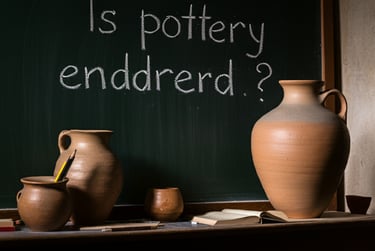Free shipping for all orders Limited Time Offer
Is Pottery Endangered?
CULTURE & HERITAGE
AB YOUSRA
11/3/20244 min read


Pottery, one of the most ancient art forms of mankind, has endured through the ages. Pottery has been used for practical, ceremonial, and ornamental reasons from the ancient civilizations of Mesopotamia to contemporary societies. Nonetheless, despite its extensive history, the craft of pottery is seeing significant challenges in many areas. The contemporary era, characterized by mass production and technical progress, has resulted in a deterioration of traditional pottery processes, prompting apprehensions over its possible extinction. Governments and communities have intervened to save this enduring skill. Through initiatives like as training programs, advertising campaigns, and the use of contemporary technology like social media, various stakeholders want to ensure the future of pottery.
The Diminution of Conventional Pottery
The deterioration of traditional pottery may be attributed to several sources. In several regions globally, mass-produced ceramics and factory-manufactured items have supplanted artisanal pottery. These industrial items are less expensive to manufacture and simpler to distribute, hence enhancing their accessibility to the common customer. Consequently, pottery, requiring specific knowledge and expertise, is sometimes seen as less practical in contrast.
Moreover, economic pressures have compelled several craftspeople to forsake their skill for more secure work opportunities. Traditional pottery requires considerable commitment of time, effort, and finances. In a more globalized environment, where rapid production and efficiency prevail, the labor-intensive characteristics of pottery may serve as a hindrance. The uncertainty of a stable income from traditional pottery significantly contributes to the downfall of the skill for many craftspeople.
Furthermore, the younger generation has a diminished propensity to engage in traditional craftsmanship. In several nations, youth are opting for contemporary jobs, resulting in the pottery heritage being relegated to an older demographic. The generational divide is a substantial obstacle to the preservation of pottery, since knowledge and skills are not being transmitted efficiently.
Governmental and Community Initiatives for Pottery Preservation
Several governments and communities have acknowledged the cultural importance of pottery and have implemented measures to safeguard this art form. In nations such as Morocco, India, and Mexico, pottery has historically been linked to national identity and cultural legacy. Governments have launched initiatives that provide financial assistance, training, and tools to aid craftsmen in sustaining their trade.
In Morocco, the government has initiated measures to preserve ancient pottery processes, particularly in locations such as Fez and Safi, renowned for their ceramic heritage. These initiatives emphasize the preservation of traditional processes while assisting craftsmen in modernizing their business strategies to align with current markets. Workshops are conducted to educate the next generation in pottery, guaranteeing the transmission of skills. Furthermore, government-operated cooperatives provide craftspeople' access to markets and equitable compensation.
The Ministry of Textiles in India has launched a strategy to promote the handloom and handicraft industries, including pottery. This effort aims to assist traditional artists via training, funding, and marketing possibilities. Furthermore, some areas in India, such as the state of Gujarat, are renowned for their pottery festivals, where craftsmen may exhibit their creations, get acknowledgment, and draw potential purchasers. Such activities enhance awareness of the need of sustaining these crafts.
The Function of Social Media in the Preservation of Pottery
Although conventional methods of pottery preservation are essential, contemporary advancements provide novel opportunities to engage a worldwide audience. Social media, specifically, has shown significant efficacy in marketing handmade ceramics. Platforms such as Instagram, Facebook, and Pinterest enable craftsmen to exhibit their creations to a broad audience without reliance on middlemen or costly marketing strategies.
Social media has fostered a new generation of pottery aficionados who appreciate the authenticity and artistry of handcrafted ceramics. Pottery influencers, craftsmen, and small enterprises have discovered that social media serves as an efficient platform for engaging with clients, showcasing their creative processes, and narrating the tales behind their creations. These venues enable ceramics to access buyers seeking distinctive, high-quality objects unavailable in mass-produced marketplaces.
In some areas, ceramic workshops and lessons are promoted via social media, highlighting the significance of sustaining the skill. These platforms not only showcase individual ceramic works but also educate the audience about the historical and cultural importance of the art form. The worldwide social media network is revitalizing and reinterpreting pottery in unique manners, drawing new clientele and securing its preservation for future generations.
Contemporary Methods in Conventional Ceramics
Although several initiatives emphasize the preservation of ancient processes, there is concurrently a drive toward the use of contemporary technology in pottery manufacture. In some regions, artists are integrating ancient techniques with new design aspects, producing works that resonate with current preferences while preserving the authenticity of the craft. The use of computer-aided design (CAD) software in the fabrication of ceramic molds allows more precision in designs, while preserving the artisanal aesthetic.
Additionally, several ceramic makers are investigating environmentally sustainable materials and methods to conform to modern principles of sustainability. The emergence of eco-conscious consumerism has prompted several potters to adopt sustainable procedures, including the use of reclaimed clay, natural glazes, and the minimization of energy usage in kilns. These changes not only sustain the craft but also make it relevant to the contemporary ecologically conscious audience.
Conclusion: The Prospects of Pottery
The future of pottery faces obstacles; yet, with collaborative efforts, it is unlikely to face extinction. Governments and communities are crucial in safeguarding this skill by providing training, support, and promotional opportunities. Contemporary technology, particularly social media, facilitate the connection between artists and worldwide marketplaces, guaranteeing that traditional pottery is accessible to a new generation of buyers. Moreover, the amalgamation of contemporary techniques with conventional processes facilitates the evolution of pottery, ensuring its relevance in a dynamic world.
By persistently honoring and advocating for the significance of pottery, we can guarantee the longevity of this enduring art form for future generations. Pottery will continue to be an essential aspect of our cultural legacy, connecting the past with the present and future, whether via government efforts, community activities, or social media influence.
Returns & Refunds policy
Privacy poliicy
Contact
Terms & conditions
Shipping policy
